Standing on the Shoulders of Yippies

Review of “No Regrets: Counter-Culture and Anarchism in Vancouver” by Larry Gambone with Further Analysis
By Llud
This article first appeared in the third edition of Wreck, Spring 2016
Unlike many other places in the world, Anarchism is a very new concept in Vancouver and throughout the coastal region of southern “BC”. Traditionally speaking, even the indigenous societies of these lands were not as anarchic as in many other places. Looking into the periods after invasion and colonization, and the conflicts within western society that also came, explicit resistance to capitalism often took the form of Marxist-Leninism brought by eastern european immigrants. Even the local wobbly chapters from the 30’s and before were of a more Marxist-Leninist character than their counterparts in many US cities. Of course there were autonomist and decentralist qualities in some of the early worker struggles but almost never with an explicitly anti-state analysis. It wasn’t until the counter-cultures of the 70’s that anarchism became an established part of the political and cultural landscape.
It is for this reason, among others, that Larry Gambone’s book “No Regrets” is an important historical document, placing anarchism among the modern tensions against capitalism and authority in Vancouver and regions nearby. It is important to transmit our history, as anarchists, geographically as well as inter-generationally; to gain a wider and more realistic perspective on the struggles we encounter, and to understand that we are contributing to something with far reaching consequences.
On a personal level, the book does a lot for me in filling in the gaps in my understanding of the historical context before my time. My parents were also politicized in the context of the 60’s and 70’s, and Larry’s thorough account of that time period answers a lot of questions I have been asking throughout my life. Most notably, how the highly subversive 60’s/70’s counter-culture could have devolved into it’s reverberations that I witnessed in my lifetime from the 90’s and afterword. But I’ll deal with this later.
In the book, which is written autobiographically, Larry details the early anarchist movement, it’s influences, and the ways it interacted with the social struggles of the time. He recounts his early flirtations with anarchism, finding out about the idea through an old Wobbly, and the SFU library, and his participation in the SFU IWW and the student struggles that took place there in the late 1960’s. He eventually found other anarchists through the youth counter-culture of the time and dropped out of the Wobbly chapter to influence social movements happening in Vancouver and the Lower Mainland, no longer being a student. He then goes on to describe the Yippies, whom himself and others eventually founded after being inspired by groups and struggles in the United States, such as Yippie (1), and the White Panthers in Detroit. Later he describes the short-lived, first explicitly anarchist groups in Vancouver, “The Volunteers” (emphasis on voluntary association) and later the “Haymarket Anarchist Tribe”. Moving out of the counter-culture of the seventies he describes the Punk subculture in it’s beginnings, being inspired by the more explicitly anarchist messages within, and coming from a slightly younger generation. He talks about the actions of the Urban Guerrilla group “Direct Action” and immediately organizing support for the group regardless of guilt or innocence. He later talks about the surprise of encountering a larger movement of anarchists decades later during and after the anti-globalization movement, which gives him the feeling of “No Regrets”.
Yippies, Anarchism, and the 60’s-70’s Counter-Culture
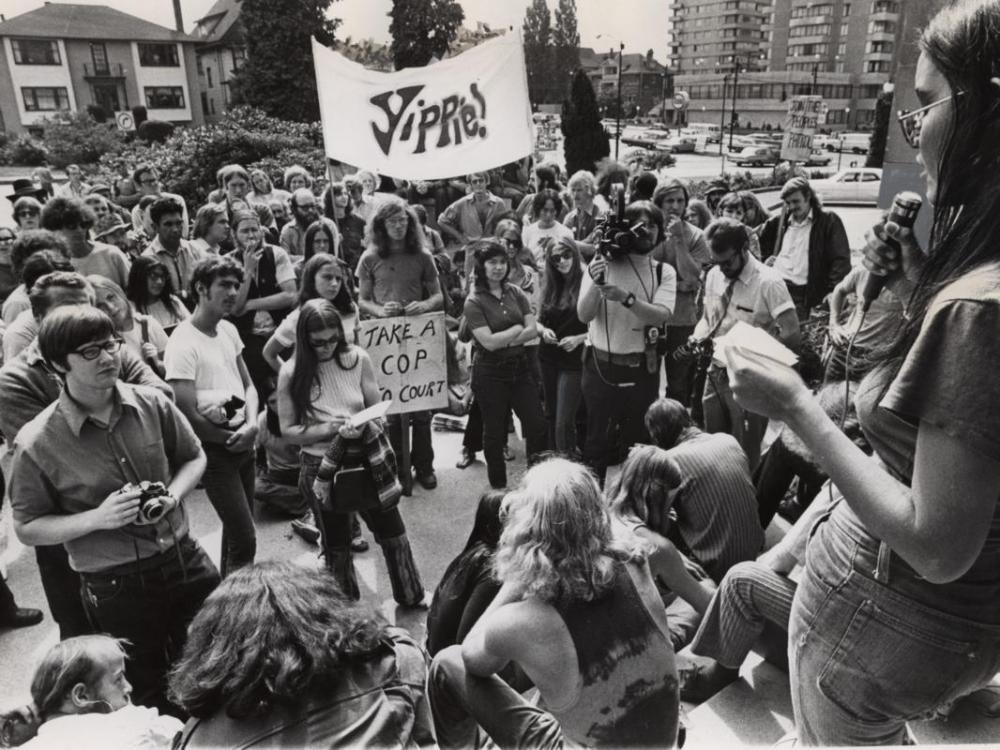
Of particular inspiration for me was his accounts of the actions of Vancouver Yippie (or “NLF”, Northern Lunatic Fringe of Yippie) who were not an explicitly anarchist group, but had a number of members who identified as anarchists, and were very anarchistic in their actions and ideas. The purpose of this group was to push the youth revolt and counter-culture in a more revolutionary direction: “turn straight people into freeks, and freeks into revolutionaries”. Some of their projects were quite interesting.
He describes the first Yippie action as a satirical “smoke in” in Cloverdale to protest the arrest of a youth in the area for giving two joints to a judge, followed by another satirical “levitate the police station” action in Vancouver where they later took over an anti-Vietnam war march and gave new life to an otherwise funeral-like procession.
On May 8th 1970, the Yippies, along-side the Vancouver Liberation Front(a marxist hippie group), organized a sit-in at the Hudson’s Bay store downtown to protest a policy in their cafeteria of not serving “longhairs”. After disrupting business for a while, they fled the building when a police assault seemed eminent and took off running and dancing down Georgia to the US Consulate. The Kent State Massacre (2) had recently happened in Ohio. Since the US Consulate was locked, they busted their way in, trashed the place, and captured the flag, flagpole and US Seal. After coming back out into the street, they burned the flag and marched back along Georgia to Granville. An undercover cop who tried to arrest someone was knocked to the ground and kicked a few times, and later a bank window got smashed before a few people were arrested and the demonstrators headed to the police station for jail solidarity.
The next day (!), came the invasion of Blaine, Washington, also organized by the Yippies and VLF. The action was in response to the US invasion of Cambodia. Around 600 people gathered at the Peace Arch border crossing and overwhelmed the border guards who, at that time, were not equipped to deal with a situation like that. They swiftly marched down into Blaine and took over Main Street, ripping down a flag and smashing a few shops, also beating up local Nazis and rednecks who came to confront them. Upon coming back across the border a few dispersed and some of those who stuck around smashed some brand new cars on a train as it came into Canada from the States.
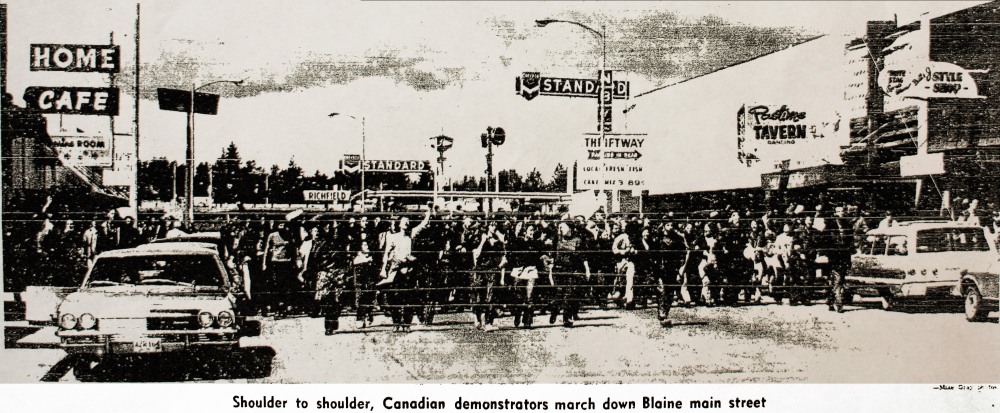
As Larry explains, the Yippies in Vancouver were not philosophically pacifist, but neither violent, nor non-violent. They had the concept of “a diversity of tactics” without having to implement it bureaucratically into their organizing or even state it explicitly. At one of their demonstrations you could have angry working-class counter-culturals ready to break shit, as well as stereotypical bubble-blowing, peace-sign throwing hippies and it wasn’t much of a conflict. A very different scene from today, when you look at the G20 anti-summit protests of 2010 for example, where there was a very formal diversity of tactics stated, but it was totally ignored by everyone from trade union bureaucrats, to environmentalists, to lefty social-democrats who denounced the riots, demanding that the police arrest rioters, and delegitimized them as agent provocateurs.
In July 1970, the Yippies organized a “be out” at Oakalla prison. After gathering at a park nearby and dancing to a rock band, the crowd of 300 people marched over and tore down some of the fence surrounding it. After invading the prison grounds for a while they were eventually pushed out by a riot squad. The action was done largely as a response to the repression of the counter-culture as a number of their people were locked inside, usually as a result of crazy anti-pot laws. Around the same time there was rioting and street fighting at English Bay, as a response to police who were harassing and arresting long hairs who frequented the public beach. Police eventually left the hippies there alone permanently, after realizing they couldn’t break their spirit.
Later that summer, in August, 13 people were arrested at Wreck Beach for “indecent exposure”. The counter-culture unanimously called for a mass “nude in” at the beach. The Yippies were involved of course. So many people came, as to completely pack the large beach. The pigs couldn’t do anything, and as a result of this action as well as the lessons the police learned at English Bay that summer, they left everyone alone (at beaches anyway). As you might have guessed, we have the hippies to thank for the continued existence of Wreck Beach as clothing-optional. But you probably weren’t aware of the fight it took to keep it that way!
A number of Yippies were involved in housing homeless youth, of which there were many. The repressive culture of the sixties, and the reaction to that coming from the counter-culture, was giving way to a massive influx of youth running away from abusive homes and other horrible situations, as they saw a possibility for more freedom. As well, there were draft-dodgers from the United States who needed housing. The social issues and “illegal” nature (massively over-emphasized as it was at the time) of some of the population brought heat down on a Hostel some from the counter-culture, including some Yippies, were running at Jericho Beach. On October 16th 1970, 200 cops and an Army squad, came to evict the youth who had barricaded themselves in the building. After being driven out, the youth blocked 4th Avenue in response. The pigs declared this an unlawful assembly and moved in, brutalizing them, even clubbing a cat and dog, belonging to the youth, to death. Using rocks and bottles, and with Yippies and VLF’ers helping however they could, a running street battle ensued as the youth were driven west to the University of British Columbia. The youth immediately moved into the Student Union Building. Right-wing elements on campus wanted to drive them from this building as well, but the youth were moved into an abandoned church in East Van before things got crazy there as well.
“The October Crisis” happened that same month, with the War Measures Act being implemented for the entire country, not just Quebec, as a response to the FLQ. In spite of the harsh penalties for such an action, Yippies and others organized a demonstration downtown. There was luckily no repression in that event.
In the 1970 Vancouver civic election, one of the Yippies, a woman who went by the name Zaria, ran for Mayor. While personally, I might not be into using such tactics, her effort was a far cry from other efforts I have seen by self-described anarchists and radicals in Vancouver civic elections since. This was by no means an attempt to moralize with the radical minority and incorporate them into the system via a social-democratic demand. Zaria’s platform included a promise to appeal the law of gravity so everyone could be high, and much of her platform was a promotion of anarchist politics to a wider audience, not with the actual intention of becoming head of a state structure or even pressuring those who would actually win. She called for self-organization of workplaces, an end to “polluting industries”, the gradual elimination of cars, the abolition of the police and courts, and a return of all Hudson’s Bay lands to natives. She even managed to get 848 votes in spite of the fact that the counter-culture vote was split by two other candidates running.

In January 1971, the BC Federation of Labour organized a demonstration in front of the BC legislature in Victoria. Buses brought people from the ferry. Yippies and VLF’ers who came for the demonstration stormed the legislature, shutting it down and causing a ruckus.
Although not included in Larry’s account, there was also a contingent of Yippies at Vancouver City College. It managed to gain control of most of student council and the editorial collective of the student newspaper. In 1971, two of it’s members were expelled from political activity on campus with the charge that, all they were doing, was “tearing the institution apart”.
On August 7th 1971, some Yippies organized a “smoke-in”, in Gastown, as a response to the heavy repression of hippies in the area. Some of the other Yippies decided not to take part in the action, which they thought was suicidal. Unfortunately, this turned out to be all too true as the Yippies and others were unable to organize an effective defense tactic for the demonstration (barricades, lots of projectiles, escape routes etc). There was indeed a great deal of repression as the police attacked and arrested 79 people, many of whom were brutalized with night sticks. The demonstration is to this day the most well known action of Vancouver Yippie. The political crisis caused by the insane brutality of the police, did however, manage to bring down the long-time rabidly anti-hippy Mayor, Tom Cambell. The Gastown Smoke-In unfortunately went down in history as a moment from which the victimized liberal citizens of Vancouver were able to eventually convince Father State of his abusive behaviour. Weed smoking, now more or less legalized in the city, is seen as a victory of appeals to the better judgement of power. We will never know of the possibilities, of what might have came, if grassroots autonomous self-defense had been successful, or even put up a better fight, in response to the brutality inherent to the state.
Earlier that same year, on May 29th, the Yippies and their supporters moved into and occupied a piece of land at the entrance to Stanley Park. The Mayor and developers had planned to build a large Four Season’s Hotel there. The occupation became known as “All Season’s Park”. With the initial occupation, 9 people were arrested for “willful damage” as a fence needed to be knocked down to get onto the site. With a great deal of local support, the occupation continued with shacks built to house a permanent presence. It wasn’t until April 21st 1972 that the last 20 occupiers were evicted. Thanks to the occupation, the city was unable to go ahead with the development. The area is now a city park.
Larry states that Yippie began to run out of steam at this time, and seemingly never fully recovered as a group. In the winter of 1971, some of it’s members went into a more introspective phase. During this period the anarchists of Yippie began to hone their theoretical understandings of anarchism, and started getting into the works of anarchist writers such as Murray Bookchin. Thanks to this period of reflection, some of this core went on the create the long standing anarchist publication “Open Road”, which had international success, and served as a precursor to Crimethinc’s “Rolling Thunder”, today probably the best anarchist magazine in North America.
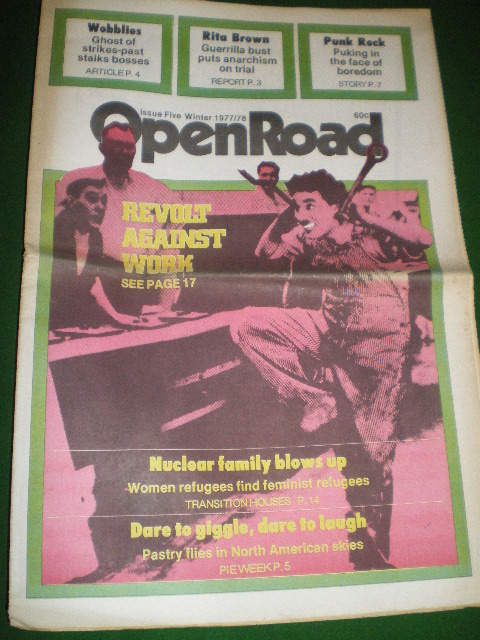
Anarchism, Counter-Culture, Social Conditions, Then and Now
Larry goes on to describe his own theoretical development, as well as the context for the fall of the counter-culture. In reading the book I found it interesting to hear about Larry’s ideas on anarchism, as an example of other anarchists of his generation, and to think of where things have gone today.
For one, sympathy for, and an uncomfortable relationship to social democracy, appear to be as much of a problem among that generation of anarchists as for this one. It would appear that Canada, the United States, and the UK are the only countries in the world where anarchists are so often willing to engage with social-democratic campaigns and groups. Maybe it has something to do with British colonialism, I’m not sure. But while Larry is highly critical in his book of attempts by some anarchists to enter and influence elements within the NDP, there is still a lot of sympathy throughout the book for people like Tommy Douglas, and implications of “good” and “bad” capitalist politicians.
In keeping with the times, Larry’s group of anarchists was beginning to place the health of the earth in higher importance than industrial development. Larry’s theoretical avenue to this, came through the social ecology of Murray Bookchin’s writings. Modern day eco-anarchist perspectives in North America come from a range of thought: from Judi Bari style, activist oriented, green syndicalism, to John Zerzan style primitivism, to the influences of interacting with traditionalist indigenous perspectives, through indigenous solidarity, to insurrectionary anarchist critiques of progress and the domesticating effects of mass society.
Interesting presently, is that the Kurdish militias associated with the formerly Marxist-Leninist PKK are practically implementing Democratic Confederalism and other Bookchinist ideas. In the wake of the collapse of the Syrian Government, the Kurds have set up autonomous regions in the north of the country, as an offensive/defensive tactic of revolutionary liberation and to stop the spread of ISIS/Daesh. They are even trying to spread these regions into Turkey. As the anarchist author Paul Z Simon’s has recently pointed out, it is interesting even more that they are moving forward, and with some success, on the principles outlined by Bookchin in “Post-Scarcity Anarchism”, in a context where there was never an industrial base. Bookchin’s ideas, when he wrote them, were intended for a highly technological post-industrial society. Comrades in that struggle have been known to make disparaging remarks of Karl Marx, and often refer to their struggle as one of putting a stop to the project of Western Civilization and doing things totally differently. Putting an end to civilization from the place of it’s beginning: the middle east. Such is the beauty of anarchy, and anarchist ideas, never to be treated as ideology, and perfect for all take or leave what we want.
Larry’s relationship to class struggle was also very interesting to read about. In spite of coming from a more workerist and federated perspective on anarchism, he pulls no punches in criticizing the pacifying and recuperative aspects of labour organizations such as the BC Federation of Labour. Not a romanticizer of the working-class, and perhaps informed by his relationship to counter-culture, he never loses his rebel spirit in hoping to “relate”. I wish I could say the same for many of the “class struggle” anarchists I meet these days.
At a few points in the book, there seems to be some misinterpretations of the insurrectionary positions of many modern anarchists. Larry doesn’t say anything about insurrectionary anarchism specifically. But I can’t guess he could be referring to anyone else when looking at statements such as this one, when he talks about the riots at English Bay in the summer of ’70:
“The riots also illuminated something I believed then and still believe now – that it is unnecessary for the revolutionary minority to advocate or practice violence. Workers and youth do not need to be told how to act. They know all about violence, it is part and parcel of their lives. When the time is right, and this has been shown over and over in history, Lenin even mentioning it, the masses are more militant than the ideological minority.”
For one, this statement is problematic in that it fails to recognize that insurrectionary anarchists see themselves as part of the mass, just with specific ideas about revolution. When we participate in whatever manner, violent or otherwise, it is because we wish to resist the specialization inherent to activist, theoretical, or militaristic paths. We also recognize that “it is in acting, that one learns to act”. If “the masses” are going on a path of revolutionary violence, we want to learn and develop with them. While workers, youth, and other groups don’t need to be told how to act violently, due to their experiences, would it not follow then that we don’t need to practice or advocate any other liberating or rebellious act? What would be the point of outreach, counter-information, re-skilling, intervening in social struggle or finding other ways of relating to each other, if we did not feel that it might help to remind people of these possibilities?
At another point in the book, he speaks of the “long-faced prunes” that militants can turn into. I feel this is a fairly valid criticism when looking at certain moments within a black bloc. Something that I too can get pretty frustrated by. Perhaps myself, and others of my generation would not have always fit in with the carnivalesque atmosphere of Yippie demonstrations of the 1970’s. But I have also experienced some of my most intense moments of joy in situations of liberating violence.
I also think some of this differing here comes down to context. Many who have a critique of pacifism are well aware of how history has been rewritten. We know well that Martin Luther King Jr and other non-violent activists were not the only face of the black liberation struggle, that much of it’s successes can in fact be attributed to the violent proletarian actions of Robert F Williams, the Black Panthers, and nameless rioters in cities throughout the US. Seemingly, less of us are aware of the proletarian elements within the counter-culture. We are subjected only to new-wave interpretations of the hippies as bubbly pacifists, who’s idealism only went as far as liberal reformism and incorporation into mainstream society. Larry’s book does an excellent job of dispelling these myths. He describes how incest, bullying and other abuse drew large numbers of poor and working-class youth into the counter-culture, often with a great deal of social problems. This context of having such a large working-class participation in social movements is much harder to fathom today.
One incident that is not covered in “No Regrets” which highlights this differing in context to me is the Rolling Stones Riot at the Pacific Colosseum in 1972. Two local gangs in allegiance, The Clark Park Gang based at the south end of Commercial Drive, and the Marxist oriented Youngbloods from another area close by, according to police and media of the time, conspired to get other youth to help them storm the venue so they could get in for free. In the melee, numerous police were injured, including one by a railroad spike shot from a homemade cannon, and molotov cocktails were tossed at their cars. While it is not clear what level of sensationalism is required to make the incident such an issue of gang involvement, it still says a lot about the context and what kind of violence the working-class youth of those days were able to engage in.
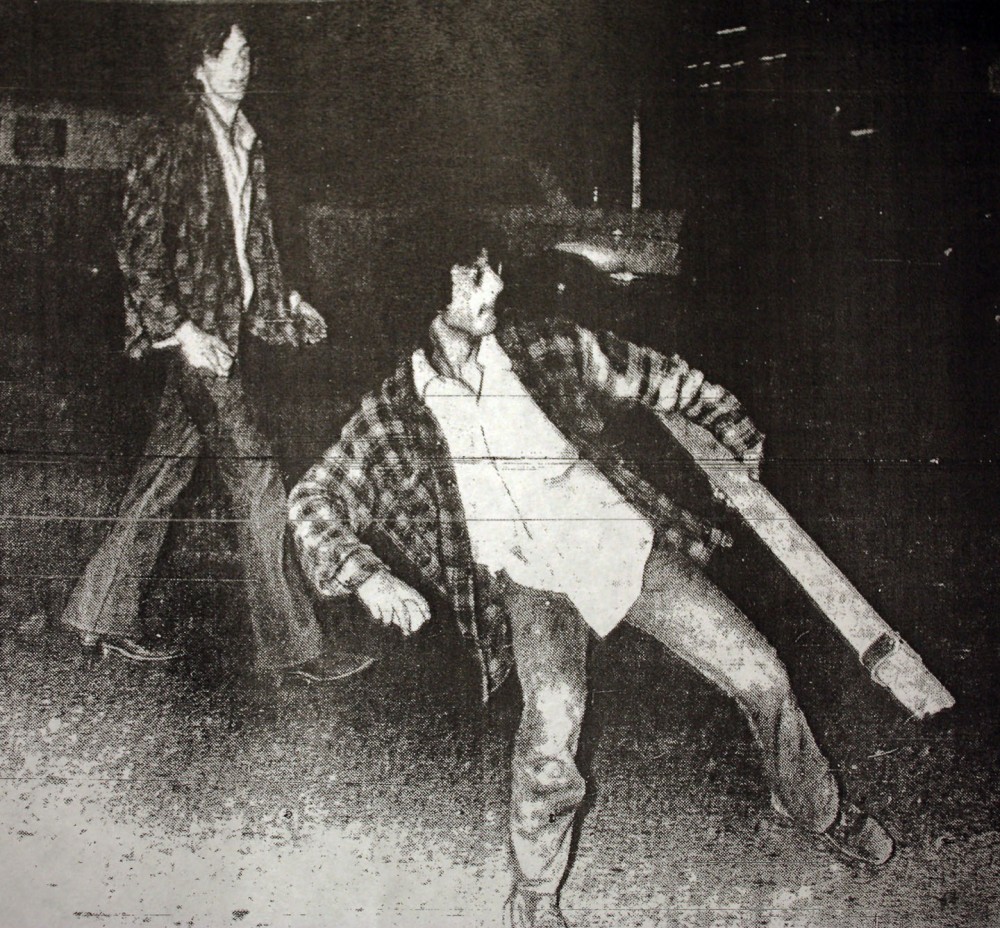
Looking around at my peers, some of whom have been sucked into modern day organizations like the United Nations, Red Scorpions, and other more independent formations, the drug war looms large over everything. The quantity of gangs, now no longer based out of parks and neighborhoods, but more through networks and distribution phone lines, is far lower. But the quality of horizontal violence, people shooting and killing each other (often over these phone lines), home invasions etc, is much more extreme. Like in the United States, neoliberalism has created the context where public spaces are more privatized, limiting our interactions, producing a more thorough snitch culture around neighborhoods, and has no doubt provided the drugs and guns that make involvement in an illegal organization one of money making and petty status, rather than one in which rebellion be can more easily produced. We live in a time when angry youth are intimately acquainted with horizontal violence, but have little avenue for the liberating violence of class war. In such a context, is it not useful for revolutionaries to send reminders that there are better targets for rage?
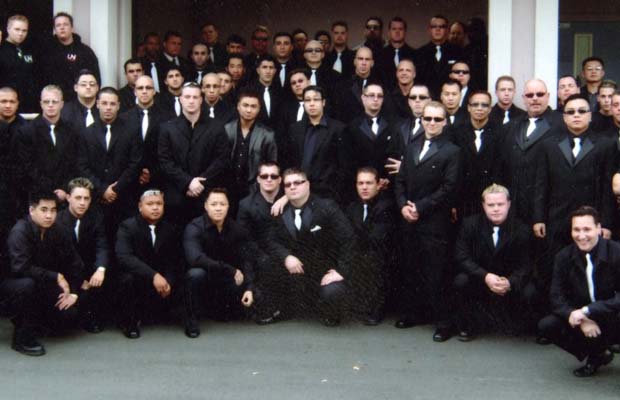
June 11, 2008 United Nations group photo
Also important for understanding this difference in context is the composition and cultural context of local social movements nowadays. We also live in a time when dancing, singing, smoking weed and being hip or alternative are a fundamental quality of the present capitalist nightmare. Back in the 70’s, singing was illegal in bars, drinking illegal restaurants, and smoking weed had heavy consequences. Further back in the 60’s dancing in whatever way you wanted was frowned upon, in no small part, due to puritanism and racism. When the Yippies and others inserted these cultural changes into their demonstrations it was a much needed break from all that came before, and was even a direct challenge to the politics of legitimacy. While today there are still some who choose to march around in circles and chant absurdly in front of buildings, there are many who engage in legitimacy politics who use the image of being hip and having fun as part of their demonstrations, and it all blends in to the dull hum of normality. I for one, would never want to go back to a form of protest that looks like a funeral procession, and have organized many demonstrations where I hoped it’s participants would act silly and have fun, but I still think it is important to recognize how much further we have to go nowadays to break ourselves out of this reality.
In “No Regrets”, Larry goes into a fair amount of detail about the social context that gave rise to the counter culture. The extreme repression it met and the counter power of networks and resources that came to be as it grew. The counter-culture developed a high level of autonomy within capitalism that we can only dream about in Vancouver today. Having heard about some of this in other places in the world, and seeing the politicizing effects that it had, through my parents, I have always wondered, what the hell happened?
It appears that there were always capitalist elements within the counter-culture, and a lot of people who remained vague about their politics. When capitalists learned that meeting this social force with brutal repression was only making matters worse, it changed it’s face, and incorporated parts of the counter-culture into it’s markets, and turned it into a sub-culture that it could buy and sell to. It appears this process was fairly rapid through the mid 70’s, and Larry describes how the early punk culture was very much a reaction to this trend.
When looking around the world today we can see that elements of the hippy counter-culture are still there in rebellious social movements around the world, and punk produces a high level of anarchist action in places like Mexico, Chile, and Indonesia. But locally, it is a very different story. Many qualities of the 70’s counter-culture, weed smoking, organic food, alternative styles, and differing relationships to sexuality are part of the most cutting edges of social capitalism. The hipster subcultures of today continually regurgitate more and more aesthetics, even such hilarious ones as “norm-core”, and place them out to be consumed and removed from context. Even traditionally rebellious sub-cultures such as punk and hip-hop are becoming almost indistinguishable from hipsterism. Especially with punk, we see that even the socially conscious tendency is recuperated into civil-society, and selfie-taking narcissism. At worst, political vagueness in punk, creates an environment where nazis can cross over and fascist symbolism is treated as just another interesting thing to look at in the mosaic of imagery. This is a very large problem in the metal scene, with the addition of neo-folk, where nazi bands such as “Death in June” are given a free pass as something harmless and ironic.
Looking Back to See Forward
One thing that came to mind when writing this article is the progression of time and context. It is kind of mind-blowing to think that at present, we are just as distant in time from the counter-cultures and the insurrectionary situations of the 60’s and 70’s, as the comrades in those days were to the 20’s and 30’s. We can also see some parallels from each time period to the next. Both the anarchist revolutionaries in Spain and the immigrant anarchists, such as the Galleanists (3), in the United States were isolated for repression, deportation, internment, and execution. And looking specifically at the North American context, the labour movement was swiftly ushered into capitalism, many labour unions having been openly white-supremacist for a while, and it is often acknowledged that it was the power of the now legalized labour movement that got Franklin Roosevelt elected. By the time the 60’s came around, labour movements may still have had a small amount of militancy. But with Keynesian economics, the continuing existence of white supremacy, greater domination of the third world, and a still very repressive overall culture, a different force was needed to rise up against capitalism. This came with the youth rebellions of the 60’s and 70’s.
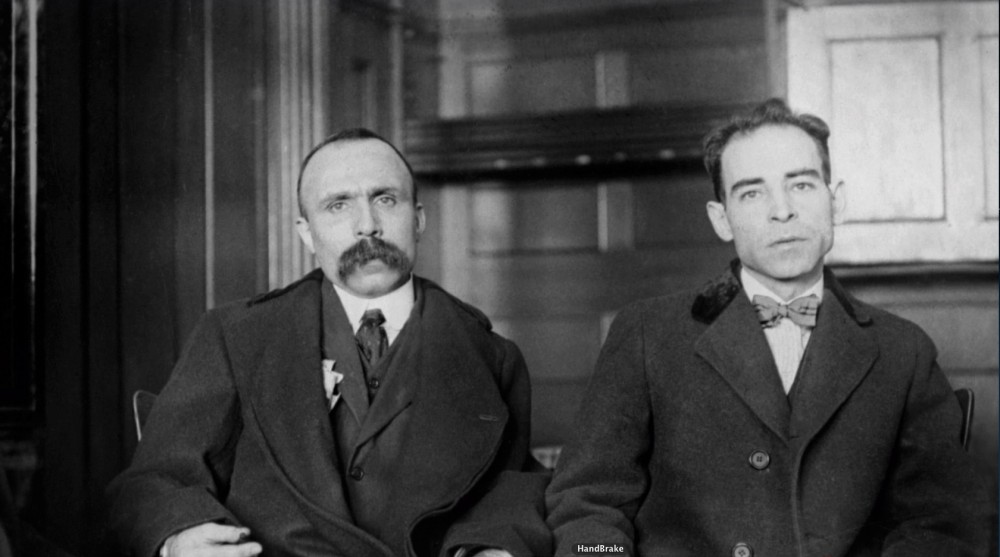
Sacco and Vanzetti
Of course this youth rebellion was happening globally, and across a lot of the baby boomer generation. In North America there was a significant rebellion manifesting in the Black and Red Power movements, the American Indian Movement, a multitude of latino organizations, and even a Hillbilly identity organization in Chicago. It’s manifestations in Vancouver, although having a higher presence of anarchists than in many other places (Marxist-Leninist-Maoism being the more common flavour of the day), were rather tame by comparison, with armed stand-offs, heavy rioting, and the formations of urban guerrilla groups being common in other places. As well, due to the white-supremacist nature of the welfare state, and exclusion from it of black, indigenous, latino, asian, and poor-white communities. Groups from these communities organized their own social programs to meet their needs. For many of these radical groups, there was a militant style of dress and a change in hair styles, that mirrored what the hippies were doing on a personal level to lose their identification with the system. For native rebels, this change in “look” took the form of growing their hair out and reclaiming aspects of their traditional cultures that had been repressed out of them.
The working class elements of the hippy counter-culture faced a high level of repression on many a day, getting attacked and beaten by cops and vigilantes in public spaces for looking different. The hippy student radicals as well, were learning the brutality that comes a long with challenging the system. But in neither case did they meet the level of genocidal violence that radicals from more categorically oppressed groups were facing. Many being framed, jailed and assassinated.
Today, we can see that in the same manner as with the labour movement, the counter-cultures and anti-colonial, anti-impirialist revolts were dealt with by isolating the radicals for repression, and removing the sea they swam in, by incorporating elements of these struggles into the system. Not only did it commodify hippy counter-culture, but it learned that slogans like “black is beautiful”, for example, could be marketed to, while still keeping white-supremacy central to beauty standards and mass media. University positions were offered to many of the present and former radicals too. As well, with the social-programs, mutual aid, and networking going on within categorically oppressed communities and even in the hippy counter-culture, the non-profit industrial complex was created to combat the tendency toward self-organization that was being developed. Today, one can wear whatever style or look they want, and get a job at a nonprofit industry, and everything continues as normal, back in the late 60’s and early 70’s this type of activity (without non-profits, or alternative capitalism existing) could have gotten you beaten, thrown in jail, or killed.
Of course the world we live in is just as much a nightmare as ever before, perhaps better in some small ways, but continually worse in most others. If workplace, and exclusively class oriented organizing was heavily blunted by the late 60’s, due to changes in social conditions, can we not say the same of subculture now? As conditions degrade, and the traditional battlefronts of social struggles in the 20th century become more recuperated and even a part of reactionary organizing, what can anarchist and other radicals inject themselves into now, that will push the boundaries of rebellion?
While we can never predict with any accuracy the next major cause of social upheaval, we know that radicals of the past injected themselves into labour organizing as well as counter-culture long before they socially exploded. We can certainly search around our present day social environment to get glimpse of what we must do, so as to ensure that fascists and other reactionary elements do not begin to dominate social upheavals, and we can instead turn them in the direction of liberation.
We can see in the United States, that organizing against the insanely murderous police has been quite successful. But we must always be in search of a more revolutionary practice that takes a more broad-based assault against the structures of domination. In addition to the police: borders, citizenship and the expansion of prisons and mass surveillance are ever-expanding problems, which we can take on as a more complete practice, and which might stop us from backing off when one simple demand gets met.
Of course there is the ever-present institution of white-supremacy, and indeed whiteness itself, which must be fought. Look back and you’ll see that power was always willing to give into certain demands, through the logic of rights, as long as it pitted one portion of the exploited against another to help them in their project of domination. Citizenship will become more powerful in this role as the years go on, but whiteness is still as strong as ever. Anarchists must always be clear and resolute that it is revolt we are concerned with, and not mere privileges, and that we have a conscious project to break away from the identities with which the ruling class ties our interests to theirs. This is as important as ever now, as new forms of fascism become more powerful by the day.
As more space and land is taken up by capitalism, and already taken space is subjected to a higher level of control, our ability to take space and land, and change our relationships to them will be of great importance. This will allow us to practice communal ways of living as well as make our relationships to the food we grow or harvest on the land something that cannot be commodified. In addition, through our differing relationships to land and ecosystems, we can build links with indigenous rebels with the same idea, and we can show others that there is an alternative to a genocidal and ecocidal economy. This land, space and the communities that develop will need to take a defensive/offensive approach to the authorities who come to remove them, otherwise they risk becoming just another subcultural lifestyle.
We can always sit and lament our being born in the present context. Waiting for a mass uprising to join in. But I would argue that it is imperative that we take the knowledge of struggles of the past to learn of their successes and failures, and to put these lessons into brand new initiatives, that change with the changing context. “No Regrets” is an important contribution towards this end, and I am happy that Larry has provided it.

No Regrets in published by Black Cat Press based out of Edmonton, AB
1 – Yippie, Youth International Party
2 – A large and militant anti-war movement existed on the campus of Kent State University, in Ohio, in the late 1960’s. After many militant demonstrations that had some property destruction, including the burning of the ROTC (Reserve Officers Training Building) on campus, the National Guard was called in, and a demonstration was called for May 4th, 1970. The national guard came to disperse the demonstration which was by now illegal, people responded to shots of tear gas with volleys of rocks, shouting “pigs off campus”. After about a half hour roving battle with the National Guard, the soldiers began firing on the demonstrators, 4 students were killed and 9 were injured by gunfire. See “Ohio” by Neil Young.
3 – Anarchists, primarily in the eastern United States, who acted and gathered with an interest in the writings and speeches of Italian immigrant anarchist Luigi Galleani.